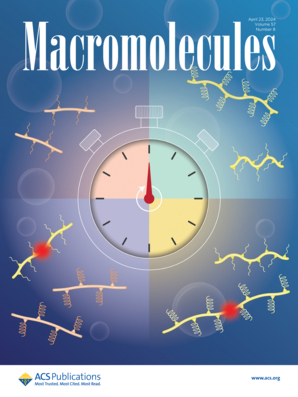Droplets, Micelles, and More Complex Structures of Polyampholyte Aggregates
IF 5.2
1区 化学
Q1 POLYMER SCIENCE
引用次数: 0
Abstract
Polyampholytes are polymers that contain both positive and negative charges, allowing them to self-assemble into various structures under specific conditions. In this study, we investigate the effects of charge sequence on the morphology of polyampholyte aggregates, focusing on chains with a moderate net charge. Using molecular dynamics (MD) simulations, we analyze how the charge sequence influences aggregate formation at varying concentrations. Our findings demonstrate that the charge sequence plays a crucial role in determining the size and morphology of aggregates, with certain sequences forming core-corona structures of the micelle type. In particular, polyelectrolyte-like charged tail sequences predominantly contribute to corona formation, influencing not only aggregate size but also its stability and dynamics. For the range of aggregate sizes explored, the fraction of chain ends participating in the corona increases linearly with the aggregation number. Despite the presence of a kinetic barrier, the equilibrium aggregation number of micelle-type aggregates can be significantly larger than that of the droplets. The presence of charged tails and the magnitude of the central net charge are key factors driving structural diversity, leading to the formation of droplets, micelles, interconnected micelles and droplets, and network-like aggregates. Additionally, charge compensation within the polymer and the condensation of counterions play significant roles in stabilizing aggregates and regulating their growth. Our current simulations do not include salt, which limits direct applicability to biological systems. The effect of the salt is discussed only qualitatively. Nonetheless, these findings enhance our understanding of polymer self-assembly and may aid in the design of polymer-based nanomaterials.

液滴、胶束和更复杂的聚集体结构
多两性聚合物是一种同时含有正电荷和负电荷的聚合物,允许它们在特定条件下自组装成各种结构。在这项研究中,我们研究了电荷序列对聚两性聚合物聚集体形态的影响,重点研究了具有中等净电荷的链。利用分子动力学(MD)模拟,我们分析了不同浓度下电荷序列对聚集体形成的影响。我们的研究结果表明,电荷序列在决定聚集体的大小和形态方面起着至关重要的作用,某些序列形成了胶束型的核心-电晕结构。特别是,聚电解质样带电尾部序列主要有助于电晕的形成,不仅影响聚集体的大小,而且影响其稳定性和动力学。对于所探索的聚合体尺寸范围,参与电晕的链端分数随着聚合体数量的增加而线性增加。尽管存在动力学屏障,胶束型聚集体的平衡聚集数明显大于液滴的平衡聚集数。带电尾部的存在和中心净电荷的大小是驱动结构多样性的关键因素,导致液滴、胶束、相互连接的胶束和液滴以及网状聚集体的形成。此外,聚合物内部的电荷补偿和反离子的缩聚在稳定聚集体和调节其生长方面起着重要作用。我们目前的模拟不包括盐,这限制了对生物系统的直接适用性。盐的作用只是定性地讨论。尽管如此,这些发现增强了我们对聚合物自组装的理解,并可能有助于聚合物基纳米材料的设计。
本文章由计算机程序翻译,如有差异,请以英文原文为准。
求助全文
约1分钟内获得全文
求助全文
来源期刊

Macromolecules
工程技术-高分子科学
CiteScore
9.30
自引率
16.40%
发文量
942
审稿时长
2 months
期刊介绍:
Macromolecules publishes original, fundamental, and impactful research on all aspects of polymer science. Topics of interest include synthesis (e.g., controlled polymerizations, polymerization catalysis, post polymerization modification, new monomer structures and polymer architectures, and polymerization mechanisms/kinetics analysis); phase behavior, thermodynamics, dynamic, and ordering/disordering phenomena (e.g., self-assembly, gelation, crystallization, solution/melt/solid-state characteristics); structure and properties (e.g., mechanical and rheological properties, surface/interfacial characteristics, electronic and transport properties); new state of the art characterization (e.g., spectroscopy, scattering, microscopy, rheology), simulation (e.g., Monte Carlo, molecular dynamics, multi-scale/coarse-grained modeling), and theoretical methods. Renewable/sustainable polymers, polymer networks, responsive polymers, electro-, magneto- and opto-active macromolecules, inorganic polymers, charge-transporting polymers (ion-containing, semiconducting, and conducting), nanostructured polymers, and polymer composites are also of interest. Typical papers published in Macromolecules showcase important and innovative concepts, experimental methods/observations, and theoretical/computational approaches that demonstrate a fundamental advance in the understanding of polymers.
 求助内容:
求助内容: 应助结果提醒方式:
应助结果提醒方式:


